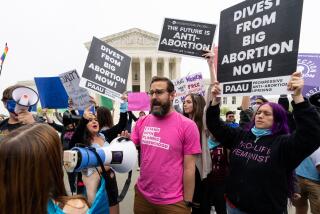Abstaining from federal sex-ed funds
In an emerging revolt against abstinence-only sex education, states are turning down millions of dollars in federal grants, unwilling to accept White House dictates that the money be used for classes focused almost exclusively on teaching chastity.
In Ohio, Democratic Gov. Ted Strickland said that regardless of the state’s sluggish economic picture, he didn’t see the point in taking part in the controversial State Abstinence Education Program anymore.
Five other states -- Wisconsin, Connecticut, Rhode Island, Montana and New Jersey -- have dropped out of that grant program or plan to do so by the end of this year. California has refused all along to participate in the program, which is managed by a unit of the Department of Health and Human Services.
Strickland, like most of the other governors who are pulling the plug on the funding, said the program had too many rules to be practical. Among other things, the money cannot be used to promote condom or contraceptive use. Students are to be taught that bearing children outside wedlock is likely to harm society and that sexual activity outside marriage is “likely to have harmful psychological and physical effects.”
And, according to the governor’s spokesman, Keith Dailey, Strickland sees little evidence that the program has been effective. “We’ve spent millions of dollars on such education since Ohio first started getting grant money in 1998,” Dailey said. “If the state is going to spend money on teaching and protecting kids, the governor believes it’s better to spend it in a smarter, more comprehensive approach.”
Strickland announced Ohio’s withdrawal from the program last month.
That states are walking away from such funding alarms abstinence-only groups, who say dozens of nonprofit sex education groups will have to close, undermining progress against teen pregnancy and sexually transmitted diseases.
States have used the money to help public and private schools with educational programs, to develop classroom instruction for nonprofits, and to pay for advertising and other media campaigns.
“There are kids who don’t want to know how to put on a condom, because they don’t want to have sex,” said Leslee J. Unruh, founder and president of the South Dakota-based Abstinence Clearinghouse, the nation’s largest network of abstinence educators. “So why can’t kids who want to abstain have equal time, funding and education in the classroom as kids who are having sex?”
To critics of abstinence-based education, the policy shift addresses growing concerns that sexually active youth aren’t getting access to medically accurate information about contraceptives and disease prevention.
In an Oct. 3 report that surveyed abstinence programs in 10 states, the Government Accountability Office concluded that such programs were not proved to work, and at times contained inaccuracies about condoms and AIDS.
In the report, one state official described an instance in which educational materials “incorrectly suggested that HIV can pass through condoms because the latex used in condoms is porous.” The official also showed that the state had “had to correct a statement indicating that when a person is infected with the human papillomavirus, the virus is ‘present for life’ because, in almost all cases, this is untrue,” the report said.
“Just saying no is not working,” said Cecile Richards, president of Planned Parenthood, which advocates comprehensive sex education, including contraceptive information. “These are efforts by the federal government to fund ideological programs, not healthcare or medical programs.”
White House support for the grants -- which are sometimes called Title V grants, for the portion of the Social Security Act under which they were established -- remains strong.
In a federal budget that is tight for nearly everything but entitlements, domestic security, and the military efforts in Afghanistan and Iraq, President Bush has asked Congress to carve out $191 million for the abstinence program in fiscal 2008 -- an increase of $28 million over current funding.
From 1995 to 2002, teen pregnancy rates dropped 24%, according to a study by Columbia University and the Guttmacher Institute. The report, published in the American Journal of Public Health in January, attributed 14% of the decline to teens waiting longer to have sex, and the rest to contraception.
Federal officials hope to prevent other states from dropping out of the Title V program. Late last month, a memo by the Family and Youth Services Bureau at the Administration for Children and Families clarified that although state agencies could only use Title V grants for abstinence-based programs, those programs could be part of a broader curriculum that includes contraception education.
“This is not an either-or-situation,” said Harry Wilson, the associate commissioner of the bureau, which manages the program.
William Smith, vice president of public policy at the Sexuality Information and Education Council of the United States, called the memo “an utterly desperate and disingenuous response to a crumbling program. The language is clear: If you get this money from the government, you teach only one thing: abstinence.”
Though most states publicly say they will continue to apply for the grants, a growing number are said to be privately considering giving up the aid -- or trying to find ways to fund a broader curriculum.
In Colorado, state senators last week passed a measure that would force school districts to incorporate science-based material in their sex education courses. Districts could still teach abstinence, but they would also have to include information on such topics as the benefits and possible medical effects of different types of contraception.
Smith said: “The question state leaders are starting to ask is, ‘How much of this is really about teaching kids, and how much of this is simply pushing forward a social policy favored by President Bush and the conservative right?’ ”
Title V grants emerged out of the 1996 overhaul of welfare programs, after Congress determined that abstinence programs should focus solely on the social, psychological and physical health benefits of chastity.
Initially, there was a public and political uproar when Congress set aside $50 million a year for states to build abstinence education programs. But when the money became available in fiscal 1998, most states had their hands out.
Not in California. State lawmakers determined that the state’s abstinence-only program had not been effective.
“We realized that we should be teaching abstinence but we shouldn’t withhold other information,” said U.S. Rep. Barbara Lee (D-Oakland), who was a state legislator at the time. Lee is part of a congressional bipartisan effort that recently reintroduced a bill to help pay for sex education that teaches abstinence and contraception.
Indeed, how states can use the Title V money, which they are required to match with $3 for every $4 received, has long been a heated issue.
Health and Human Services endured enormous criticism by governors last year after it issued a document underscoring and clarifying key rules for states that took federal abstinence grants. Among the points that unsettled some state officials: Applicants “must not” promote contraceptive or condom use, nor even “refer to abstinence as a form of contraception.”
In the months that followed, states started to turn away from the program. In October, New Jersey said it would do without the $800,000 it had been receiving. Wisconsin followed in March, when Democratic Gov. James Doyle said the state would no longer accept nearly $600,000.
“When we got that first memo, that did it for us,” said Stephanie Marquis, a spokeswoman for the Wisconsin Health and Family Services Department. “How can we do our best to teach the teens that are sexually active if our hands are tied?”
The rejection of the funds came as a blow to the nonprofit Center for Self-Sufficiency in suburban Milwaukee. It runs abstinence classes in schools and church groups statewide, as well as supporting efforts in New Jersey, Maryland and New York. Doyle’s decision means the center will lose at least 20% of its annual $2.3-million budget, said its chief executive, Angela Turner.
“This whole debate has been hijacked by politics,” Turner said. “Everyone’s arguing, but everyone seems to forget that we all agree on one thing: Youth need to be educated about sex.”
More to Read
Sign up for Essential California
The most important California stories and recommendations in your inbox every morning.
You may occasionally receive promotional content from the Los Angeles Times.









